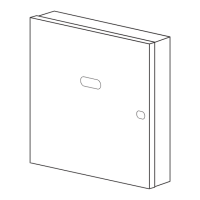Do you have a question about the First Alert FA168CPS and is the answer not in the manual?
Proper intrusion coverage requires sensors at every point of entry.
Recommends NFPA 72 for smoke/heat detector placement and number.
Details burglary protection modes (Stay, Night-Stay, Away, Instant, Maximum) and chime mode.
Explains the use of 4-digit security codes for arming, disarming, and system functions.
Covers arming with security codes, quick arming, step-arming, and disarming.
Describes how alarms sound, messages sent to monitoring stations, and stopping alarms.
Covers OFF, Arming modes, BYPASS, CHIME, TEST key functions.
Allows time to leave after arming; system arms fully when it expires.
Provides time to disarm the system upon re-entry.
Explains exit error conditions and "exit alarm" messages.
How to check for open zones before arming using the [*] key.
Arms perimeter only (Stay) or perimeter plus selected zones (Night-Stay).
Arms perimeter only with entry delay off, for no expected entry/exit.
Arms entire system (Away) with delay or (Maximum) without delay.
Details the key sequences for Stay, Night-Stay, Instant, Away, and Maximum modes.
Explains how to use a keyswitch for arming and disarming the system.
How to disarm the system, silence alarms, and clear memories.
How to bypass zones to arm the system with specific zones unprotected.
How to bypass all open zones automatically without entering numbers.
How to manually activate emergency functions using panic keys.
Explains master and user security codes and their assignment.
Command strings for adding/deleting codes, assigning levels, groups, partitions, RF users, and pager status.
Steps to create and program schedules for various events.
Explains the purpose and procedure for weekly system testing.
Explains "CHECK" and "BATTERY" messages, common causes, and troubleshooting.
Emphasizes calling for service if "CHECK" display cannot be resolved.
Information on sensor batteries, replacement, and low battery indicators.
Describes the 24-hour fire alarm system, detectors, and sounds.
How to manually trigger a fire alarm using panic keys.
NFPA 72 recommendations for smoke/heat detector placement.
Steps for establishing and practicing fire escape plans.
Explains carbon monoxide detection and alarm procedures.
Table to track system users, their codes, authority levels, and partitions.
Continues the user setup tracking table with more user entries.
Details system limitations, potential failures, and user responsibilities.
Proper intrusion coverage requires sensors at every point of entry.
Recommends NFPA 72 for smoke/heat detector placement and number.
Details burglary protection modes (Stay, Night-Stay, Away, Instant, Maximum) and chime mode.
Explains the use of 4-digit security codes for arming, disarming, and system functions.
Covers arming with security codes, quick arming, step-arming, and disarming.
Describes how alarms sound, messages sent to monitoring stations, and stopping alarms.
Covers OFF, Arming modes, BYPASS, CHIME, TEST key functions.
Allows time to leave after arming; system arms fully when it expires.
Provides time to disarm the system upon re-entry.
Explains exit error conditions and "exit alarm" messages.
How to check for open zones before arming using the [*] key.
Arms perimeter only (Stay) or perimeter plus selected zones (Night-Stay).
Arms perimeter only with entry delay off, for no expected entry/exit.
Arms entire system (Away) with delay or (Maximum) without delay.
Details the key sequences for Stay, Night-Stay, Instant, Away, and Maximum modes.
Explains how to use a keyswitch for arming and disarming the system.
How to disarm the system, silence alarms, and clear memories.
How to bypass zones to arm the system with specific zones unprotected.
How to bypass all open zones automatically without entering numbers.
How to manually activate emergency functions using panic keys.
Explains master and user security codes and their assignment.
Command strings for adding/deleting codes, assigning levels, groups, partitions, RF users, and pager status.
Steps to create and program schedules for various events.
Explains the purpose and procedure for weekly system testing.
Explains "CHECK" and "BATTERY" messages, common causes, and troubleshooting.
Emphasizes calling for service if "CHECK" display cannot be resolved.
Information on sensor batteries, replacement, and low battery indicators.
Describes the 24-hour fire alarm system, detectors, and sounds.
How to manually trigger a fire alarm using panic keys.
NFPA 72 recommendations for smoke/heat detector placement.
Steps for establishing and practicing fire escape plans.
Explains carbon monoxide detection and alarm procedures.
Table to track system users, their codes, authority levels, and partitions.
Continues the user setup tracking table with more user entries.
Details system limitations, potential failures, and user responsibilities.
| Model | FA168CPS |
|---|---|
| Battery Backup | Yes |
| Test/Silence Button | Yes |
| Low Battery Signal | Yes |
| Color | White |
| Number of Zones | 8 |
| Mounting | Wall |
| Warranty | Limited Warranty |
| Power Source | AC Power Adapter |












